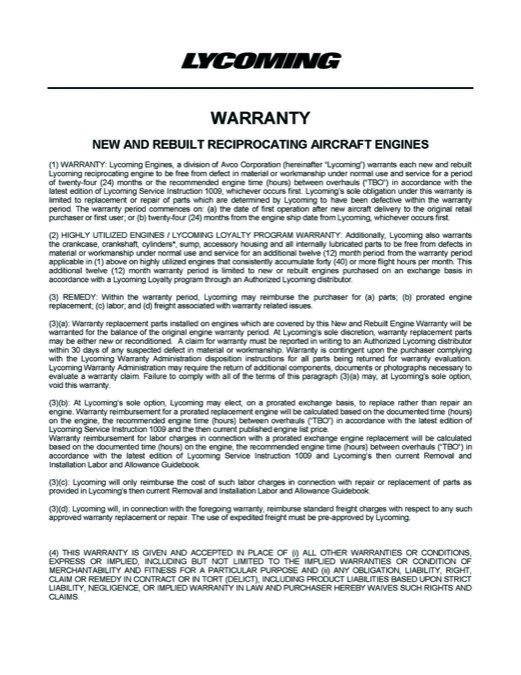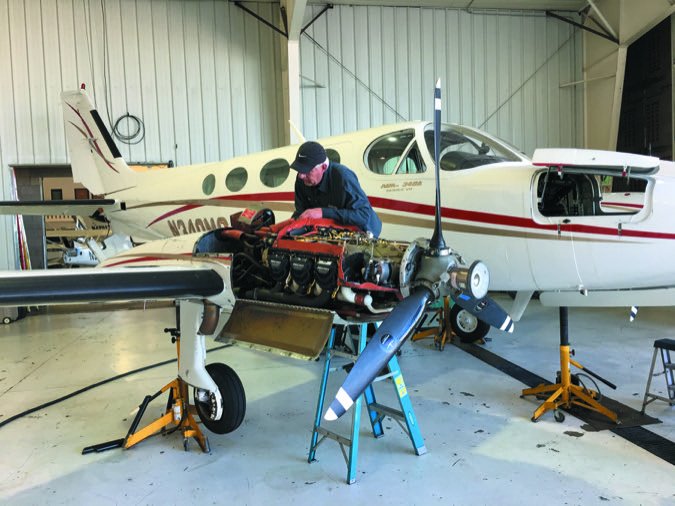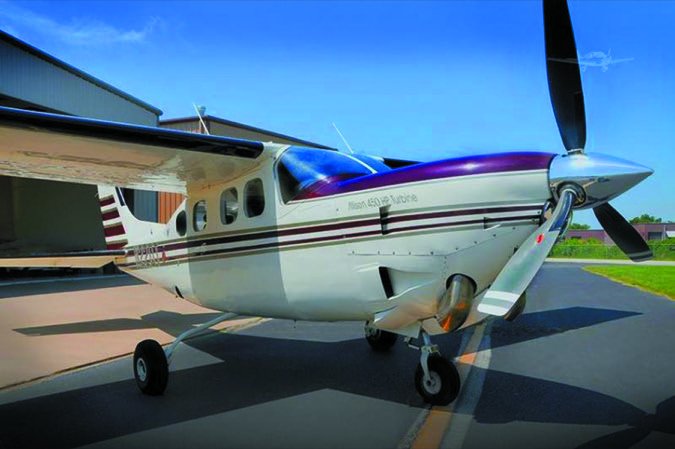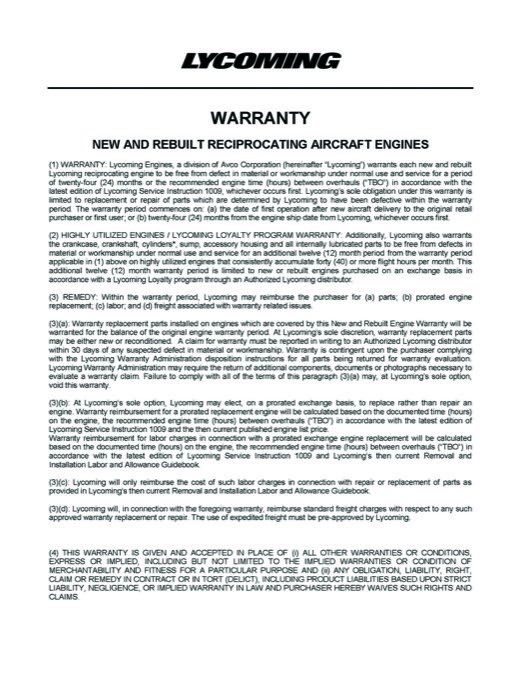It’s been heard ever since commerce began: “I want my money back!”
You bought something and now it doesn’t work. What recourse do you have? Can you compel the seller to exchange the bad something for a new one? If you return it, are you entitled to a refund of the full purchase price? Will the seller pay the full cost of getting it fixed? What if the something is three months old? A year? Five years? How long is the seller obligated to repair a defective product, exchange it or take it back and refund your money?
While the odds of a reader of this magazine buying a new airplane this year are low, the odds that that same reader will be buying new avionics (ADS-B, remember?), having an engine overhauled or having the family airplane upgraded in some fashion approach unity. That means that you may be faced with a problem with the new something on your airplane and you’ll want to get it fixed without having to shell out any more money. That brings us front and center to a discussion of warranties, what they are, what they require a manufacturer or seller to do and how they can be limited to restrict the buyer’s rights when something does go wrong.
Background

We’ll start by pointing out that warranty law varies from state to state, so if you wind up in a fight with a seller, you’re going to need to look to your state laws to find out the specifics as to the rights you have. That being said, the state laws regarding warranties are more alike than different, so it’s worth going through a discussion of warranty law generally-while pointing out that this article is not legal advice and that you should consult a lawyer who knows your state law on warranties should you get into a big disagreement with a seller.
The underlying notion behind warranty law is that when someone makes something and sells it, or fixes a broken something, that maker/seller/repair shop makes an implied warranty that the something will do what it is supposed to do-and keep doing it. If it doesn’t do what it’s supposed to do, the maker/seller/repair shop is obligated to stand behind its work-either take the product back and return the buyer’s money, fix it or replace it with another product that does what the first one was supposed to do. For how long? A “reasonable” period of time.
The problem is obvious-lack of certainty. For the buyer it’s uncertainty as to what he or she is going to get if the aircraft breaks or the maintenance didn’t fix the underlying problem. For the builder/seller/repair shop, it’s uncertainty regarding what it will have to do if the product breaks and for how long.
Limited Warranty
One of the most effective ways to kill off business is to introduce uncertainty-and an implied warranty means major uncertainty. State laws long ago evolved a way to wipe out most of the uncertainty in the warranty world. The laws allow the builder/seller/repair shop to limit its repair/replace/refund obligations by providing the buyer a written warranty that clearly states what it will and won’t do when the product doesn’t work.
A written, limited warranty also sets out what the buyer must do to take advantage of the written warranty should something break.
The written warranty becomes part of the agreement the buyer makes with the builder/seller/repair shop when the buyer buys an aircraft or component or has maintenance performed. Part of the transaction you enter into when you buy a factory-new engine or GPS-comm or have an annual inspection done on your airplane involves buying a warranty on the work.
Owner Obligations
We strongly recommend that a prospective buyer read the warranty carefully to determine what is covered and what her or his obligations are. The big one is what the owner has to do to get work and parts paid for. Often, the work has to be done at a shop approved by the manufacturer-which can be expensive if no such shop is nearby or if the airplane has to be moved under a ferry permit. We’ve seen no warranties that pay the owner’s cost of getting the airplane to and from an approved shop.
We have seen warranties that will pay for parts and labor at the owner’s shop-most of those place limits on the number of hours of labor for various repairs. If your shop doesn’t know your type of airplane well, you may be on the hook for the cost of its learning curve.
Recommendations

Our recommendations when it comes to warranties:
• Read the warranty before you buy an aircraft, component, have a refurb done or maintenance performed. If you don’t like it, see if you can negotiate a different one-it’s not often possible, but it’s worth a try.
• If you don’t like the warranty, go elsewhere for the product or service if you can.
• If something breaks during the warranty period, report it immediately and get in line to have it fixed under the warranty. If you wait until a day after the warranty expires, the seller can justifiably deny coverage.
• If something breaks during the warranty and you have it fixed under the warranty and then it breaks again, report it and demand that it be fixed under the warranty even if the warranty has expired. In our experience, repeated failure of a component with multiple attempts to fix it or replace it is an indication of a more serious problem. By being the squeaky wheel, we’ve seen manufacturers step up and continue to fix an ongoing problem involving the same component or system if the problem first manifested itself during the warranty period.
• Don’t be a jerk. If your claim for warranty repairs is in the gray area of covered versus not covered, you increase your chances of coverage by stating your position professionally and clearly outlining what it is you want. Yelling and screaming at the person handling your claim is a good way to have the decision be “not covered.”
Consequential Damage
When a component fails and damages other things, such as the engine or the airplane, the question of the extent of warranty coverage arises. If a connecting rod made out of improper materials fails during the warranty period, there is no question-the warranty will pay to replace the rod. However, if the con rod failure trashes the engine, will the warranty pay for repairs to the entire engine or is that something to be paid for by the owner’s insurance? The answer lies in the terms of the warranty and the aircraft insurance policy. Trying to sort out the answer to events such as a defective con rod and engine destruction or defective side link in a landing gear that leads to a gear collapse and damage to an airframe and engine is the stuff that drives lawsuits.
In general, a warranty covers the cost of repairs to a component that is found to be defective. If the component causes further damage to the engine or airframe-not through wear, but due to a sudden stoppage, failure or collapse-the owner should look to the insurer to pay for repairs.
Which Warranty?
Unlike cars where the buyer deals with only the manufacturer for warranty repairs, airplanes are usually covered by a number of separate warranties-at the least, airframe, engine, propeller and avionics.
That means the buyer must learn the coverage of each and comply with the terms of each one to have repairs paid for under the warranty. That also means keeping track of expiration dates of each warranty. We don’t like it, and we think it’s foolish and unfair to someone shelling out the kind of bucks involved with a new airplane purchase-but it’s a fact of life for many aircraft purchases and the owner must proceed accordingly.
Warranty or Insurance? Trapped In The Gap
In 1997, Joel Rosenlicht bought a 1979 Cessna P210. He flew the pressurized single for 10 years before taking it to O & N Aircraft for its Silver Eagle mod. Five months and $770,000 later the original 310-HP Continental TSIO-520 had been replaced with a 450-HP Rolls-Royce 250-B17F turboprop engine and the airframe had been significantly modified to handle the additional power. The result was a truly high-performance single that cruised over 200 knots in the flight levels and could safely use grass runways-capabilities that Rosenlicht needed for his business.
Over the next 11 years, Joel flew his Silver Eagle extensively. He told us that it met his needs almost perfectly. He had the annuals performed at O & N Aircraft and then at Griggs Aviation when it took over the Silver Eagle STC after the death of O & N’s founder.

In May 2018 chip light #3 illuminated three times in 10 hours of flight. The engine has three chip lights that correspond to chip detectors in three locations in the engine. The engine was inspected after the first two chip light events and a small bit of metal was found. After the third, Griggs Aviation recommended that the aircraft be brought to them for further inspection.
Chris Murley of Griggs told us that, in consultation with Keystone Turbine Services, the engine was pulled and sent to Keystone for evaluation.
Because of the location of the chip detector that had flagged metal in the engine, the gearbox was opened up. Inside, techs found a half-inch polishing stone, sometimes called polishing media, with a gouge in its side. The stone was the sort that was used to polish gears during the manufacturing process. Because the gearbox is essentially a sealed unit, it was likely that the stone had been in the gearbox in a benign location for 10 years before it shifted and started causing damage to components within the gearbox.
At that point things started getting confusing. In consultation with his insurance broker, Rosenlicht made an insurance claim. According to Rosenlicht, his insurer initially indicated that it was going to pay the claim and subrogate against Rolls-Royce. However, as time went by and more and more people, including the FAA and Rolls-Royce, got involved, the issue of who would pay for repairs to the engine became fluid.
We reached out to Rolls-Royce for comment but received no reply-unacceptable. We were unable to find a copy of the Rolls-Royce warranty from 2007; however, the current warranty has calendar and engine-hour time limits for warranty coverage with the longest possible coverage time being four years. We think it’s reasonable to assume that the 2007 warranty was similar.
The FAA looked at the engine. Its report is so highly redacted that its conclusion is unclear-although it did not issue an AD calling for inspection of engines built contemporaneously with Rosenlicht’s.
Even presuming that the stone was missed during inspections when the engine was built and its presence was a manufacturing defect, it appears to us that Rolls-Royce would be within its rights and the law to deny a warranty claim because its written warranty put a time limit on its obligation to repair a manufacturing defect.
As is usually the case for insurance policies on turbine aircraft, Rosenlicht’s policy covered damage from FOD. However, what is FOD? The stone was a foreign object that caused damage, but it is unlikely that it was sucked into the engine when it was on the aircraft. Rosenlicht’s insurer, Alliance, declined to pay.
After extended discussions, Rolls-Royce paid to replace the gearbox and some other engine components.
Rosenlicht was left with a bill for $70,000 for the remainder of the work that was done to the engine plus the cost of removing and replacing it and transport to and from the engine shop. He also ate the cost of several months of downtime. He took out a loan to cover the cost. He is again flying the airplane.
Rosenlicht’s plight is similar, on a larger scale, to what many aircraft owners have dealt with after a warranty expires-the gap between warranty and insurance coverage. Something goes badly wrong-for example, an inspection reveals that all six cylinders must be replaced. Insurance doesn’t cover the situation-although it would have paid to replace the airplane if one of those cylinders came apart in flight and the airplane was torn up in the subsequent forced landing.
The owner may have been carefully setting aside money each hour for an engine overhaul, but the fund isn’t big enough yet to cover the needed work. The owner is facing an expense that may require unloading the unrepaired airplane at a loss.
The gap between warranty and insurance coverage can mean facing crippling costs, especially on older aircraft.
We pass this story along with the caveat to prospective owners-an airplane and engine may require a substantial investment before each reach the end of their working lives. It’s wise to plan accordingly.
Conclusion
We couldn’t afford to buy airplanes or engines, or pay for maintenance, if manufacturers and repair shops were on the hook for repairs indefinitely-so we have limited warranties. That means considering the terms of the warranty as a part of the overall purchase.





